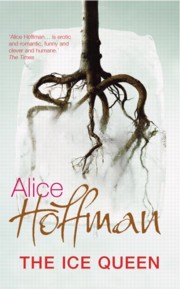THE ICE QUEEN by Alice Hoffman
 I am trying to work out why I picked up this book (US)(UK). Maybe it was the picture on the cover, (the UK one is of roots in ice, the US one is below), or maybe it was the title -THE ICE QUEEN- the name of my favourite Hans Christian Andersen's fairy story, or maybe it was the name of the writer - someone I'd heard of but never read, but mainly I think it was because I opened the book and read on the first page: 'Be careful what you wish for. I know that for a fact. Wishes are brutal unforgiving things...'
I am trying to work out why I picked up this book (US)(UK). Maybe it was the picture on the cover, (the UK one is of roots in ice, the US one is below), or maybe it was the title -THE ICE QUEEN- the name of my favourite Hans Christian Andersen's fairy story, or maybe it was the name of the writer - someone I'd heard of but never read, but mainly I think it was because I opened the book and read on the first page: 'Be careful what you wish for. I know that for a fact. Wishes are brutal unforgiving things...'This is a powerful book, full of beautiful, weird and exotic imagery, and remarkable 'facts' about lightning strikes. Alice Hoffman takes the incredible but true - people struck by lightning can have strange branch-like burns on their bodies - and exaggerates them so they become fantasy - a man struck by lightning becomes too hot to touch, and has the image of a man's face burnt onto his back - in this way the boundary between fact and fiction is blurred.
 The narrator of the book, like the child in the fairy story, acquires a splinter in the heart when she wishes that her mother were dead - and that wish comes true. That splinter causes the protagonist to become frozen, not fully alive, and she consequently develops an interest in death. Her employment as librarian allows her to research into ways of dying which in turn leads to her one relationship - with a policeman who shares her interest in forensics. There are touches of humour, mainly of the black kind.
The narrator of the book, like the child in the fairy story, acquires a splinter in the heart when she wishes that her mother were dead - and that wish comes true. That splinter causes the protagonist to become frozen, not fully alive, and she consequently develops an interest in death. Her employment as librarian allows her to research into ways of dying which in turn leads to her one relationship - with a policeman who shares her interest in forensics. There are touches of humour, mainly of the black kind. Another death causes her to migrate from New Jersey and follow her brother to Florida. The brother is a scientist, a meteorologist, someone with little emotional intelligence - the archetypical cold scientist in fact, and for most of the book they continue their distant relationship. There are two further pivotal moments: the first when she is struck by lightning which gives her a second chance at life; and another towards the end of the book when she makes a disturbing discovery about the health of her brother. This is what finally causes the splinter to thaw.
The themes of the book are coldness and death - not a particularly good choice for the festive season, then, especially for someone recently bereaved - and in retrospect the death motif should have been obvious to me from the first few pages. However I continued to read because it made me think (miserably, but still it made me think) about having time and not having time, and of the advantages and disadvantages of sudden death without warning and the more protracted sort.
The narrator in this book had time to make her brother's wish come true - a scene involving butterflies - and also a chance to answer the question of what is the best way to die. The answer at the end was a happy one.

0 Comments:
Post a Comment
Comments are subject to moderation.
<< Home